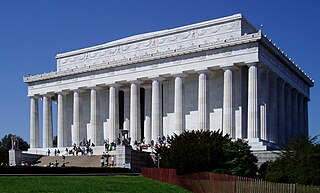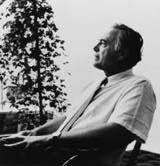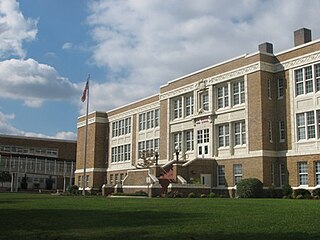
Henry Bacon was an American Beaux-Arts architect who is best remembered for the Lincoln Memorial in Washington, D.C., which was his final project.

Harry Mohr Weese was an American architect who had an important role in 20th century modernism and historic preservation. His brother, Ben Weese, is also a renowned architect.

CambridgeSeven Associates, Inc. (CambridgeSeven) is an American architecture firm founded in 1962 and based in Cambridge, Massachusetts. The original seven partners, Lou Bakanowsky, Ivan Chermayeff, Peter Chermayeff, Alden Christie, Paul Dietrich, Tom Geismar, and Terry Rankine apply diverse skills in architecture, planning, exhibit design, graphics, industrial design, and film making to create a single design studio founded on the conviction that each assignment, at any scale, should be an opportunity to apply fresh thinking in search of creative solutions. The firm was founded upon the idea that the collaborative efforts of a varied group of designers and architects would be far more effective than those of any one individual. In writing about the firm, the architecture critic Robert Campbell stated, "From the start, the Seven set out to combine architecture with the other design arts - with exhibits, with graphics, and signage, with public art, with product design, with film, even with city planning. Most of their work is a collaboration among many disciplines ..." The practice won the American Institute of Architects Architecture Firm Award in 1993, and was described by the AIA Committee on Design as "an influential and stimulating example, demonstrating new directions of professional practice."

Samuel Sloan was a Philadelphia-based architect and best-selling author of architecture books in the mid-19th century. He specialized in Italianate villas and country houses, churches, and institutional buildings. His most famous building—the octagonal mansion "Longwood" in Natchez, Mississippi—is unfinished; construction was abandoned during the American Civil War.

Walker & Gillette was an architectural firm based in New York City, the partnership of Alexander Stewart Walker (1876–1952) and Leon Narcisse Gillette (1878–1945), active from 1906 through 1945.
George Matsumoto was a Japanese-American architect and educator who is known for his Modernist designs.

John Howey is a Florida architect known as part of the group of architects at work since 1965 that followed the Sarasota School of Architects led by Paul Rudolph. John Howey Associates is his Tampa Bay architectural firm formed in 1973. Some of his projects include Tampa City Hall Plaza, Village Presbyterian Church, and the Williers Residence in Tampa. John Howey died on Saturday, October 26, 2019.
Philip Goodwin Freelon was an American architect. He was best known for leading the design team of the Smithsonian Institution's National Museum of African American History and Culture.
Frank Harmon is a writer, architect, professor and public speaker in Raleigh, North Carolina.

Joseph Florence Leitner was an American architect whose work includes several rail stations. In Columbia, South Carolina he worked for Charles Coker Wilson for five years. Later he partnered with William J. Wilkins (architect), first in Florence, South Carolina and then in an office in Wilmington, North Carolina, where Leitner practiced for a decade. to form Leitner & Wilkins. His work included commercial, educational, fraternal religious, industrial, residential, and transportation buildings in colonial revival architecture, Flemish architecture (especially gables, Italianate architecture and Romanesque revival architecture styles. He ended his career in Florida.

William J. Wilkins was an American architect in Florence, South Carolina and in partnership with Joseph F. Leitner in Wilmington, North Carolina.
Leslie N. Boney Sr. (1880–1964) was an American architect who focused on schools. He designed approximately 1,000 schools or additions to schools, and his works appear in 51 of North Carolina's 100 counties.
Lewis James Clarke was born in Carlton, Nottinghamshire, England. He is a landscape architect of the Modernist period. Clarke was one of Dean Henry L. Kamphoefner's early faculty members at the North Carolina State University School of Design, and has been recognised as the founder of several fields of study one of which was the introduction of ecological principles into the field of landscape architecture
Henry H. Kendall was an American architect from Boston, Massachusetts. He wrote a letter to the U.S. Civil Service commission critiquing the low pay for government architects. Kendall was the senior partner in the firm Kendall, Taylor & Company. Several of his or the firm's works are listed on the U.S. National Register of Historic Places, for their architectural merit.
Edward "Terry" Walter Rail Waugh was a South African architect known for helping to bring Modern architecture to the southern United States and North Carolina in particular through his association with the School of Design at North Carolina State College.
Arthur Ralph Cogswell, Jr. was an American architect known for his work in the Modernist school, primarily designing homes in North Carolina.
William Ransom (Bill) Campbell Jr. was an American architect. He was a member of a group of modernist architects in North Carolina that had a major academic and architectural influence on the Modernism movement in the 1950s through 1970s.
Glenn Allen Jefferson Buff was an American architect. North Carolina has the third highest number of Modernist residences in the country. Modernist design became popular in the US in the 1930s, primarily in California, and expanded east through the 1960s. Glenn Buff was one of the architects who contributed to the state's design heritage during that time by influencing the modernist movements and designing modernist houses for people. Buff contributed by designing modernist houses and influencing the movement with his work.
Ronald Lawrence Mace, FAIA was an American architect, product designer, educator, and consultant. He is best known for coining the term universal design and for his work advocating for people with disabilities.

Ligon B. Flynn, FAIA (February 24, 1931 – September 26, 2010} was an American Architect who practiced in North Carolina — widely known for his coastal residential projects of southeastern North Carolina, notably in the Wilmington area.








